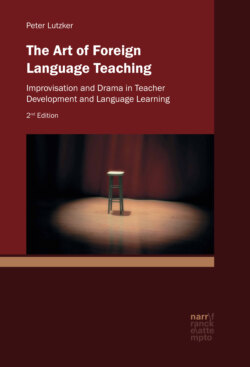Читать книгу The Art of Foreign Language Teaching - Peter Lutzker - Страница 73
На сайте Литреса книга снята с продажи.
6.4.5 Exercises in Groups of Three or More
ОглавлениеAfter the first solo improvisations and the improvisations in pairs, the next step to larger groups of three is, in comparison, a relatively small and manageable one. At this point, new structures are involved. For the first time there is a clear theme and structure given to the improvisation within which the participants are improvising together.
The improvisation called The Siamese Twins bears clear relations to the imitation exercises in the warm-ups and to the partner improvisations insofar as two participants who come into the room one after the other suddenly discover that they’re doing exactly the same things. Trying to imitate the other without knowing or planning what is going to happen next clearly presents a number of challenges and problems, all very much in the spirit of clowning. After a few minutes of the twins attempting to deal with their ‘sameness’, a third participant who does not know that they will be there, enters the stage – in turn surprising the ‘twins’. The discovery of the others creates very rich possibilities for living through and enjoying the manifold problems which emerge.
The improvisation Theatrical Audition is also often done with three participants and involves Gladwell directly in the task as a kind of participant/facilitator. Three clowns present themselves as a company of actors auditioning for a director/producer (Gladwell). This theme allows for the theatrical convention of ‘the play within a play’. However, through their eye contact with the audience, along with the fact that they actually have no idea what play they are auditioning with, this exercise clearly remains within the domain of clowning. That Gladwell as the producer has a vast repertoire of appropriate problems and difficulties for this troupe of actors also adds a great deal to the dynamics, energy and humour of this situation.
